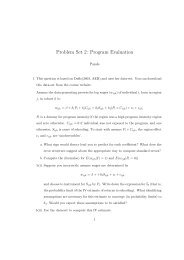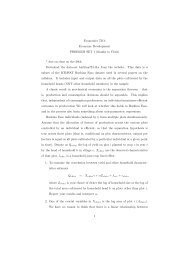The Expected Utility Model: Its Variants, Purposes, Evidence and ...
The Expected Utility Model: Its Variants, Purposes, Evidence and ...
The Expected Utility Model: Its Variants, Purposes, Evidence and ...
You also want an ePaper? Increase the reach of your titles
YUMPU automatically turns print PDFs into web optimized ePapers that Google loves.
Schoemaker: <strong>The</strong> <strong>Expected</strong> <strong>Utility</strong> <strong>Model</strong><br />
555<br />
struction of NM utility functions. As Cornelius<br />
Van Dam (1973) <strong>and</strong> Karmarkar<br />
(1978) have shown, 5050 reference lotteries<br />
will often lead to a different NM<br />
utility function than, for example, would<br />
result if 30-70 lotteries had been used.<br />
Furthermore, as shown in Hershey <strong>and</strong><br />
Schoemaker (1980) <strong>and</strong> Tversky <strong>and</strong><br />
Kahneman (1981), subtle changes in the<br />
context or framing of a problem may lead<br />
to different preferences (see also Don<br />
Wehrung et al., 1980). Thus the question<br />
arises which context measures the "true"<br />
risk-taking attitude (Jim Barnes <strong>and</strong> James<br />
Reinmuth, 1976, <strong>and</strong> Hans Binswanger,<br />
1980) or more fundamentally, whether<br />
there really exist basic tastes <strong>and</strong> preferences<br />
that are compatible with the EU<br />
axioms. A recent study by Hershey, Kunreuther<br />
<strong>and</strong> Schoemaker (1982), focusing<br />
on response mode biases, probability distortions,<br />
translation effects, risk transfer<br />
asymmetries <strong>and</strong> context effects, suggests<br />
that the answer to the latter question is<br />
no.16<br />
One solution many normative theorists<br />
(e.g., Keeney <strong>and</strong> Raiffa, 1976) would recommend<br />
is to explain to the decision<br />
maker his or her inconsistencies <strong>and</strong> see<br />
if a revision of preference(s) is desired. For<br />
instance, MacCrimmon (1968) found that<br />
executive subjects would often change<br />
their choices when made aware of violations<br />
of normative postulates (e.g., those<br />
of Savage, 1954). However, social pressure<br />
<strong>and</strong> conformity tendencies may have confounded<br />
these results. In a follow-up<br />
study, Slovic <strong>and</strong> Tversky (1974) controlled<br />
for these influences. As mentioned<br />
earlier, they tested Savage's independence<br />
principle by presenting subjects<br />
l6 Recent experiments suggest that the mathematical<br />
EU form of separable f(p) <strong>and</strong> U(x) transformations<br />
is questionable (John Lynch, 1979 <strong>and</strong> Lehner,<br />
1980). Rather than reflecting risk-attitude indirectly<br />
in U(x), it is proposed that the utility function explicitly<br />
incorporates probability, i.e., EU = Ef(pi)<br />
U(x, pi).<br />
with the Allais (1953) <strong>and</strong> Ellsberg (1961)<br />
paradoxes. Once subjects had made their<br />
choices, they were then given a prepared,<br />
authoritative argument against their particular<br />
choice (i.e., either Allais' position<br />
or that of Savage). After reflecting on<br />
these arguments, the subjects were subsequently<br />
asked to reconsider their choice.<br />
Except for a few individuals, most subjects<br />
did not change their preferences, many<br />
of which were in violation of Savage's independence<br />
principle. Indeed, even<br />
among experts these paradoxes evoked<br />
considerable debate concerning the normative<br />
acceptability of the EU postulates<br />
(e.g., Sarnuelson, 1952; Allais, 1953; Savage,<br />
1954; Raiffa, 1961; <strong>and</strong> Ellsberg, 1961<br />
<strong>and</strong> 1963), which brings us to the second<br />
normative implication.<br />
As MacCrimmon <strong>and</strong> Larsson (1979)<br />
noted: "since many careful, intelligent decision<br />
makers do seem to violate some axioms<br />
of expected utility theory, even upon<br />
reflection of their choices, it does seem<br />
worthwhile exploring this third option of<br />
considering modifications of the st<strong>and</strong>ard<br />
theory" (p. 83). In this vein Chew <strong>and</strong><br />
MacCrimmon (1979a <strong>and</strong> 1979b) recently<br />
proposed an alternative generalized EU<br />
model, in which the substitution axiom is<br />
considerably weakened. Mark Machina<br />
(1982) showed that the major economic<br />
concepts <strong>and</strong> tools of EU analysis do not<br />
depend on the independence axiom. As<br />
an alternative route, Loomes <strong>and</strong> Sugden<br />
(1981) proposed to drop the transitivity<br />
axiom, both descriptively <strong>and</strong> normatively.<br />
Finally Fishburn (1981) recently<br />
developed an alternative preference representation<br />
that utilizes neither the transitivity<br />
nor the independence axiom.<br />
Apart from modifications to the normative<br />
model two other o~tions were Dresented<br />
by MacCrimmin <strong>and</strong><br />
(1979), namely: (1)to maintain that one's<br />
choices are valid <strong>and</strong> that the assumptions<br />
Or axioms do not apply in the given case,<br />
or (2) to change one's choices to conform




